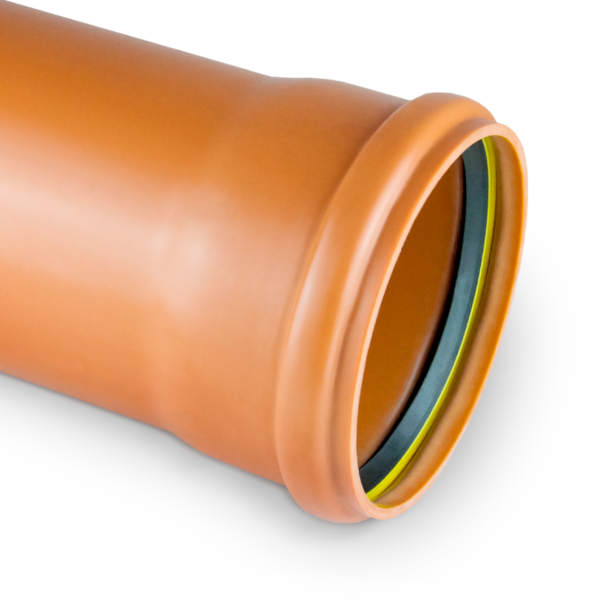Technical characteristics:
The sewage pipe system made of PP is produced in the diameter range DN/OD 110 – 800 mm and in the stiffness classes SN 2, SN 4, SN 8, SN 12, SN 16. Pipes for outer sewage are orange-brown (RAL 8023), uniform in terms of shades and intensities with a smooth outer and inner surface. All types of sewer pipes and fittings are connected between each other and with smooth-wall pipes through sockets with a groove in which an elastomer seal is placed.
Polypropylene (PP) is a material with high resistance to chemical compounds. Pipe systems made of PP in accordance with this standard are resistant to a wide range of pH 2 (acid) to pH 12 (base), corrosion caused by water such as municipal sewage, rainwater, surface water and groundwater. Information on the chemical resistance of PP material is given in ISO/TR 10358: 1993, regarding rubber materials in ISO/TR 7620: 2005. The PP sewage system with gaskets is resistant to maximum permanent sewage temperature above +90 C. Pipes and fittings are resistant to abrasion. In special cases, abrasiveness may be tested in accordance with the method given in EN 295-3.
Standards:
EN 1852-1 – Plastic pipe systems for underground pressureless drainage and sewerage — Polypropylene (PP) — Part 1: Specification of pipes, fittings and system
EN 13476-2 – Plastic piping systems for underground non-pressure drainage and sewerage — Pipe systems with structural walls made of unplasticized poly (vinyl chloride) (PVC-U), polypropylene (PP) and polyethylene (PE) — Part 2: Pipe and fittings with a smooth inner and outer surface and system, type A
Advantages of PP pipes and fittings:
Full tightness
High impact strength
High resistance to point pressure
High longitudinal rigidity
Total corrosion resistance of pipe surfaces
High durability of the system (over 100 years)
hemical resistance in a wide range of pH, corrosion caused by mediums such as municipal sewage, rainwater, surface water and groundwater
High hydraulic smoothness of the pipe surface
The thermal resistance allows the installation of pipes at temperatures down to -20 ° C, and the transfer of sewage at 90 ° C in a continuous manner


